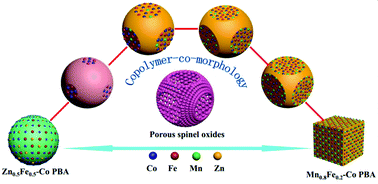A “copolymer-co-morphology” conception for shape-controlled synthesis of Prussian blue analogues and as-derived spinel oxides†
Abstract
The morphologically and compositionally controlled synthesis of coordination polymers and spinel oxides is highly desirable for realizing new advanced nanomaterial functionalities. Here we develop a novel and scalable strategy, containing a “copolymer-co-morphology” conception, to shape-controlled synthesis of various types of Prussian blue analogues (PBAs). Three series of PBAs MyFe1−y[Co(CN)6]0.67·nH2O (MyFe1−y–Co, M = Co, Mn and Zn) with well-controlled morphology have been successfully prepared through this strategy. Using MnyFe1−y–Co PBAs as the model, by increasing the relative content of Mn, flexible modulation of the morphology could be easily realized. In addition, a series of porous MnxFe1.8−xCo1.2O4 nano-dices with well-inherited morphologies and defined cation distribution could be obtained through a simple thermal treatment of the PBAs. All these results demonstrate the good universality of this novel strategy. When evaluated as an electrocatalyst, the octahedral-site MnIII/MnIV content in MnxFe1.8−xCo1.2O4, mainly determined by sensitive 57Fe Mössbauer in combination with X-ray photoelectron spectroscopic techniques, was discovered to be directly correlated with the oxygen reduction/evolution reaction (ORR/OER) activity.


 Please wait while we load your content...
Please wait while we load your content...